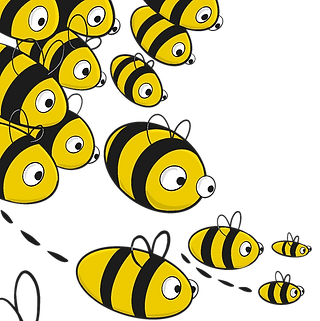
BEE SWARMING - EXPLAINED
The phenomenon of honeybees swarming happens between late spring and early summer.
Just before a colony swarms, the bees will start to make a new Queen.
The swarm contains the old Queen bee and about 20,000 worker bees leaving the remaining bees.
The swarm creates a loud hum with the air thick of swirling bees.
They initially settled as a ball often hanging from a bush or tree not far from the hive.
They can stay there for several days while the scout bees look for a permanent home.
The bees are very gentle and present little danger. They have all eaten a lot of honey from their old hive!
(It is a bit like a bee holiday!)
They send out the scouts to find the best new home. On their return, these brave bees dance to the Queen.
How vigorous the dance is, depends upon how excited the scouts are about the new home they have found.
Once the Queen chooses the 'best dancer', the colony fly to their new home.
Honeybees are finding it hard to survive in the wild. It is important to collect swarms where possible.
Remember, although the bees present little danger, it is best not to disturb them.
Always contact your local beekeepers’ association to collect them safely!
The lucky swarms will be re-housed into beehives and become productive colonies.
Many new beekeepers start out with a swarm.
Let’s save our bees!
A special thank you to Ivor Kemp from the
East Dorset Beekeepers’ Association for his technical expertise.
For more information on bees, you can visit the following websites:
The International Bee research association https://ibra.org.uk/
The British Beekeepers Association https://www.bbka.org.uk/
The Bournemouth And Dorset South Beekeepers https://www.bads-bka.org/





